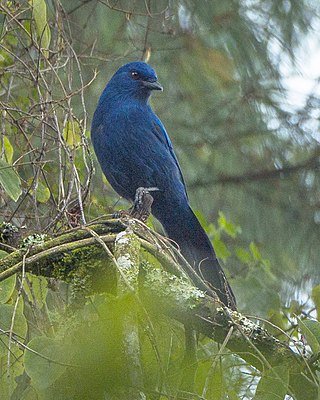
Tickell's thrush is a passerine bird in the thrush family Turdidae. It is common in open forest in the Himalayas, and migrates seasonally into peninsular India, Nepal and rarely to Bangladesh.

The Indian Swiftlet or Indian Edible-Nest Swiftlet is a small swift. It is a common resident colonial breeder in the hills of Sri Lanka and south west India.

Bonitos are a tribe of medium-sized, ray-finned predatory fish in the family Scombridae – a family it shares with the mackerel, tuna, and Spanish mackerel tribes, and also the butterfly kingfish. Also called the tribe Sardini, it consists of eight species across four genera; three of those four genera are monotypic, having a single species each. Bonitos closely resemble the skipjack tuna, which is often called a bonito, especially in Japanese contexts.

The sambar is a large deer native to the Indian subcontinent, South China and Southeast Asia that is listed as a vulnerable species on the IUCN Red List since 2008. Populations have declined substantially due to severe hunting, local insurgency, and industrial exploitation of habitat.

The unicolored jay is an Aphelocoma jay native to cloud forests of northwestern Central America and southern and southeastern Mexico, from central Honduras west to central Guerrero, southern Veracruz and extreme southern San Luis Potosí. It is apparently a basal member of its genus. At Montebello, Chiapas, it is a cooperative breeder, and is not known to perform mating dances.

The Antipodes parakeet or Antipodes Island parakeet is a parrot in the family Psittaculidae that is endemic to the Antipodes Islands of New Zealand. It is one of two parrot species found on the islands, and one of only five ground-dwelling parrots in the world. They are long-living birds that may live up to 10 years of age, but the introduction of mice that compete with them for food was a threat to their survival on the Antipodes Islands until the mice were successfully eradicated from the Islands in 2016. Unusually for parrots, they sometimes prey upon other birds, a trait shared by another New Zealand parrot, the kea.
The short-furred Atlantic tree-rat or Wagner's Atlantic tree rat, is a spiny rat species found in Brazil.

The brown lanternshark or bristled lanternshark is a little-known species of deep-sea dogfish shark in the family Etmopteridae. It is found off Japan and New Zealand, and possibly also South Africa and Australia, typically deeper than 300 m (980 ft). This species can be distinguished from other lanternsharks by its coloration, which is a uniform dark gray or brown without the ventral surface being much darker and clearly delineated from the rest of the body. The brown lanternshark feeds on small bony fishes, cephalopods, and crustaceans. Reproduction is ovoviviparous, with females giving birth to 9–18 young. An unusually high proportion of individuals in Suruga Bay are hermaphrodites, with both male and female characteristics.

The Banggai crow is a member of the crow family from Banggai regency in the province of Central Sulawesi in Indonesia. It is listed as critically endangered by IUCN. It was feared extinct, but was finally rediscovered during surveys on Peleng Island off the southeast coast of Sulawesi by Indonesian ornithologist Mochamad Indrawan in 2007 and 2008.

The variable oystercatcher is a species of wader in the family Haematopodidae. It is endemic to New Zealand. The Māori name is tōrea-pango. They are also known as 'red bills'.

The brown-tailed mongoose, brown-tailed vontsira, Malagasy brown-tailed mongoose, or salano is a species of mammal in the family Eupleridae. It is endemic to Madagascar. Its natural habitat is moist lowland tropical forest. It is threatened by habitat loss.

The Sambirano woolly lemur, also known as the Sambirano avahi or unicolor woolly lemur, is a species of woolly lemur native to western Madagascar.

Leiopotherapon unicolor, the spangled grunter or spangled perch is a species of ray-finned fish, a grunter from the family Terapontidae. It is endemic to Australia.

Sybra is a genus of beetles in the family Cerambycidae, containing the following species:
Sybra iconica is a species of beetle in the family Cerambycidae. It was described by Pascoe in 1865. It contains two subspecies, Sybra iconica clarevitticollis and Sybra iconica iconica.

Sybra umbratica is a species of beetle in the family Cerambycidae. It was described by Pascoe in 1865.
Sybra uenoi is a species of beetle in the family Cerambycidae. It was described by Hayashi in 1956. It is known from Japan.
Sybra bioculata is a species of beetle in the family Cerambycidae. It was described by Pic in 1925. It contains four subspecies: Sybra bioculata bioculata, Sybra bioculata quadrinotata, Sybra bioculata sikkimana, and Sybra bioculata tigrina.

Sybra ordinata is a species of beetle in the family Cerambycidae. It was described by Henry Walter Bates in 1873.
Sybra pascoei is a species of beetle in the family Cerambycidae. It was described by Lameere in 1893.














